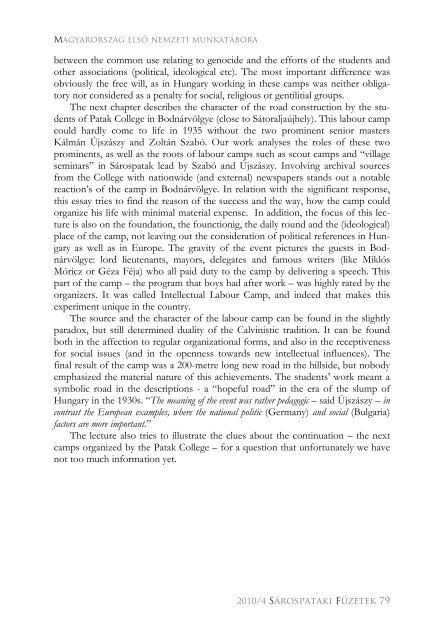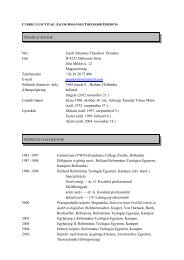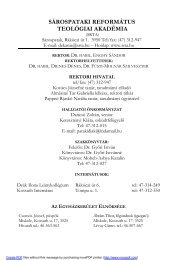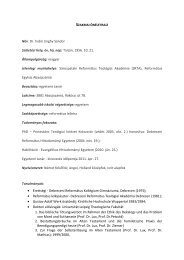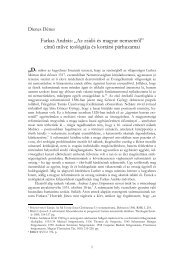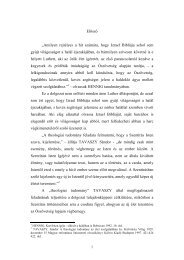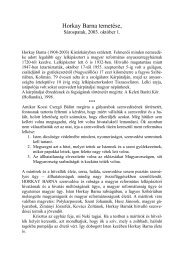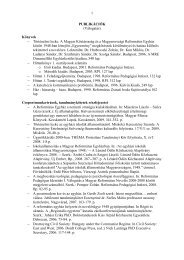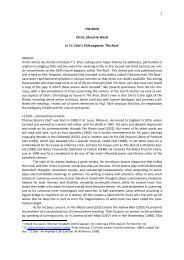Bartha Ákoskább abban a miliőben, melyben létrejött. A harmincas évek Magyarországa ugyanisaz útkeresések ideje volt (maradva a már említett útszimbolikánál). Generációskülönbségek, ideológiai viták és politikai csatározások jellemzik ezt az időszakot,melyben a világgazdasági válság addig ismeretlen léptékű gazdasági problémákatgenerált. Az ország a trianoni döntés után éppen, hogy megtanulta kezelni megváltozottkereteit, újrafogalmazni lehetőségeit, gazdasági működését, mikor egy újabb,ám ezúttal világléptékű trauma érte. Nyilvánvaló volt, hogy az új kihívásra új válaszokszükségeltettek. Ez a változtatási igény természetszerűleg nagyon sok iránybanyitott utakat, ám szinte minden szanálási terv számolt a vidék lakosságával, legtöbbjükegyenesen programjának fókuszába helyezte az egyetlen jelentős társadalmiréteget, mely még nem kompromittáltatta magát a válságos évtizedekben, tehát aparasztságot. A szavakat tetteknek kellett követnie az új válaszok értelmében, így a„huszonévesek” hozzáláttak a magyar falu megismeréséhez, a falukutatáshoz. Létrejötta népiek belülről igen laza, ám kívülről annál markánsabbnak látszó konglomerátuma,akik többnyire már származásuknál fogva is az új idők mellett demonstráltak.Ebben a közegben döntöttek úgy a sárospataki diákok, hogy a nép életének(faluszemináriumbeli) megismerése mellett, elérkezett az idő a nép munkájánakmegismerésére, tehát a munkatáborra, mely – mint láthattuk – korántsem magyartalálmány. A hazai táborok megalakulásához nagyban hozzájárultak a fenti tendenciák,bár a szociális változásokat váró közhangulat kevésnek bizonyult a komolypolitikai reformokhoz. A változások, melyeknek a pataki diákok is hírnökei voltaktorzóban maradtak, így a történelem Oláh György szomorú jóslatát igazolta, aki aMunkatábor Vendégkönyvébe a következőket jegyezte be: „ez a kétszáz méteres útszakaszolyan messzeségekbe vezet, hogy félek, kevesen jönnek majd rajta utánatok.” 113AbstractThe first labour camp in Hungary: the road constructionby the students from SárospatakThe sociological researches of villages in the 1930s have flourished in Hungaryencouraged by economical, social, historical, as well as ideological factors. Fromthis well-known activity evolved a real physical work, the “labour camp”. Thephrase of “public work” was familiar in this region earlier - there were more exampleseven from the 19 th century for non-paid state labour. However, the bestknown connection with this term was not from this period and neither from thisinterpretation. Due to the historical facts the “labour camp” and “labour draft”phrases received pejorative meanings - universally associated with the concentrationcamps of the Nazi Empire (or the soviet’s Gulags), and the Jewish hard labourduring World War II. The first part of this present essay offers an internationalsurvey of the term “labour camp”, with particular emphasis on the differences113 SRKTGyA, Fsz. Kt. 3282.78 Sárospataki Füzetek <strong>2010</strong>/4
Magyarország első nemzeti munkatáborabetween the common use relating to genocide and the efforts of the students andother associations (political, ideological etc). The most important difference wasobviously the free will, as in Hungary working in these camps was neither obligatorynor considered as a penalty for social, religious or gentilitial groups.The next chapter describes the character of the road construction by the studentsof Patak College in Bodnárvölgye (close to Sátoraljaújhely). This labour campcould hardly come to life in 1935 without the two prominent senior mastersKálmán Újszászy and Zoltán Szabó. Our work analyses the roles of these twoprominents, as well as the roots of labour camps such as scout camps and “villageseminars” in Sárospatak lead by Szabó and Újszászy. Involving archival sourcesfrom the College with nationwide (and external) newspapers stands out a notablereaction’s of the camp in Bodnárvölgye. In relation with the significant response,this essay tries to find the reason of the success and the way, how the camp couldorganize his life with minimal material expense. In addition, the focus of this lectureis also on the foundation, the founctionig, the daily round and the (ideological)place of the camp, not leaving out the consideration of political references in Hungaryas well as in Europe. The gravity of the event pictures the guests in Bodnárvölgye:lord lieutenants, mayors, delegates and famous writers (like MiklósMóricz or Géza Féja) who all paid duty to the camp by delivering a speech. Thispart of the camp – the program that boys had after work – was highly rated by theorganizers. It was called Intellectual Labour Camp, and indeed that makes thisexperiment unique in the country.The source and the character of the labour camp can be found in the slightlyparadox, but still determined duality of the Calvinistic tradition. It can be foundboth in the affection to regular organizational forms, and also in the receptivenessfor social issues (and in the openness towards new intellectual influences). Thefinal result of the camp was a 200-metre long new road in the hillside, but nobodyemphasized the material nature of this achievements. The students’ work meant asymbolic road in the descriptions - a “hopeful road” in the era of the slump ofHungary in the 1930s. “The meaning of the event was rather pedagogic – said Újszászy – incontrast the European examples, where the national politic (Germany) and social (Bulgaria)factors are more important.”The lecture also tries to illustrate the clues about the continuation – the nextcamps organized by the Patak College – for a question that unfortunately we havenot too much information yet.<strong>2010</strong>/4 Sárospataki Füzetek 79
- Page 5:
Oktass,hogy éljek!
- Page 8 and 9:
Barnóczki AnitaKezdet és vég egy
- Page 11 and 12:
Busch, EberhardGibt es reale Gründ
- Page 13 and 14:
Gibt es reale Gründe glücklich zu
- Page 15 and 16:
Gibt es reale Gründe glücklich zu
- Page 17 and 18:
Gibt es reale Gründe glücklich zu
- Page 19 and 20:
Busch, EberhardDie Sendung der ganz
- Page 21 and 22:
Die Sendung der ganzen christlichen
- Page 23:
Die Sendung der ganzen christlichen
- Page 26 and 27:
Busch, Eberhardständnis könnte au
- Page 28 and 29: 28 Sárospataki Füzetek 2010/4Busc
- Page 31 and 32: Püsök SaroltaGyarapodni Isten és
- Page 33 and 34: Gyarapodni Isten és emberek előtt
- Page 35 and 36: Gyarapodni Isten és emberek előtt
- Page 37 and 38: Gyarapodni Isten és emberek előtt
- Page 39 and 40: Gyarapodni Isten és emberek előtt
- Page 41 and 42: Gyarapodni Isten és emberek előtt
- Page 43: Gyarapodni Isten és emberek előtt
- Page 46 and 47: Csohány Jánosgessé váló politi
- Page 48 and 49: Csohány János1860. január 11-én
- Page 50 and 51: Csohány Jánostanács rendeletben
- Page 52 and 53: Csohány JánosAbstractThe Final Ph
- Page 54 and 55: Győri L. Jánosazaz a 16. századb
- Page 56 and 57: 56 Sárospataki Füzetek 2010/4Győ
- Page 58 and 59: Győri L. Jánoségett. És hálás
- Page 60 and 61: Bartha Ákoste, és munkatáborrá,
- Page 62 and 63: Bartha Ákoskon és a korabeli film
- Page 64 and 65: Bartha Ákosvallanak az iratok, 24
- Page 66 and 67: Bartha Ákos„falumunka” koncepc
- Page 68 and 69: Bartha Ákosmeg a nagy visszhangot
- Page 70 and 71: Bartha Ákosvalószínűleg a munka
- Page 72 and 73: Bartha Ákossajtó ellene irányul
- Page 74 and 75: Bartha Ákosnap is megkapja a maga
- Page 76 and 77: Bartha Ákosták meg étkezésüket
- Page 81 and 82: Enghy SándorZofóniás apokalipszi
- Page 83 and 84: Zofóniás apokalipszisének elemz
- Page 85 and 86: Zofóniás apokalipszisének elemz
- Page 87 and 88: Zofóniás apokalipszisének elemz
- Page 89 and 90: Zofóniás apokalipszisének elemz
- Page 91 and 92: Zofóniás apokalipszisének elemz
- Page 93 and 94: Zofóniás apokalipszisének elemz
- Page 95 and 96: Zofóniás apokalipszisének elemz
- Page 97 and 98: Zofóniás apokalipszisének elemz
- Page 99: Zofóniás apokalipszisének elemz
- Page 102 and 103: Rogerson, John W.csak nagyon időig
- Page 104 and 105: Rogerson, John W.BevezetésMilyen f
- Page 106 and 107: Rogerson, John W.Az alkalmazkodás
- Page 108 and 109: Rogerson, John W.miszerint a tört
- Page 110 and 111: Rogerson, John W.még egy olyan rag
- Page 113 and 114: Rácsok GabriellaReframing Theology
- Page 115 and 116: Recenzióamelyek hozzájárulhatnak


